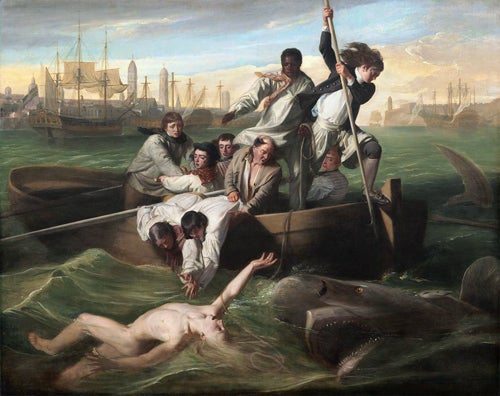
On a warm day in 1749, 14-year-old Brook Watson dove into Havana Harbor for a swim. As he floated surrounded by merchant ships, a shark sank its teeth into his leg, pulling him beneath the waves in a vicious, sustained attack that severed his right foot. Bleeding and helpless, he struggled to stay above water as a group of sailors maneuvered a small skiff into position and pulled him from the toothy Behemoth’s mouth. His leg would have to be amputated at the knee, but he survived his ordeal. Nearly thirty years after the incident, John Singleton Copley historicized Watson’s attack in the monumental painting Watson and the Shark.
Copley was a successful painter who left America for Europe after the outbreak of the Revolutionary War, seeking to some extent to escape political turmoil—his wife’s family were staunch loyalists while he cautiously supported independence—which he thought artists should avoid. His letters show a man concerned with joining the ranks of Europe’s most respected painters and gaining wealthy patrons. He writes of a desire to create history paintings, considered the most technically challenging and important genre of painting at the time, to elevate his career.
It is not known how Copley learned of Watson’s past, but it is believed Watson approached Copley for a commission in which he saw great opportunity. In Watson and the Shark, Copley upended the traditions of genre painting by heroizing contemporary figures taking part in real events rather than depicting traditional religious, mythical, and allegorical subjects, successfully gaining the acclaim he sought upon leaving America.
The painting caused a sensation at the Royal Academy, where it was exhibited in 1778 under the exceptionally explanatory title A boy attacked by a shark, and rescued by some seamen in a boat; founded on a fact which happened in the harbour of the Havannah. Audiences shocked by the painting’s dramatic and grisly content were even more amazed by the novel treatment of a true event, an approach only seen previously in Benjamin West’s 1770 work The Death of General Wolfe. Critics complimented Copley’s masterful telling of a tale focusing on the heroism of common men. Citing a 1778 newspaper review in which the author gives a detailed account of the story and concludes that the rescuers “nobly exerted themselves,” historian Louis P. Masur writes:
“For this writer, the story is one of heroic action in the face of terror, of compassion for the sufferer in the face of insatiable greed and cosmic indifference. It is the story of a few… common men who worked together and ‘nobly exerted themselves.’ Literally history from below, the painting reenacts a pitched battle between demons from the depths and men who labor just above the surface. In this horrifying instant, history is democratized and the anonymous seaman are shown to be as deserving as any general of the temporal and spiritual rewards of virtuous, selfless action.”
Scholarship on Watson and the Shark suggests several interpretations of the painting’s meaning, including views that it represents the struggle between forces of good and evil, serves as racial commentary, or that it is a political allegory about the American Revolution. None of these arguments are conclusive, as Copley (perhaps tellingly) provided very little insight into his inspiration for the work other than describing it as a story “founded on a fact.” In a 2012 article in American Art, Jonathan Clancy argues that the painting focuses exclusively on “the power of human agency.” Indeed, the anonymous sailors who rescued Watson made the decision to battle nature and succeeded. In an inspirational tale of 18th-century bootstrap hoisting, Watson recovered and triumphed over his early misfortunes, becoming a successful merchant, soldier, and politician, and holding positions such as Lord Mayor of London, chairman of Lloyd’s, and commissary general to the forces of Great Britain.
Watson’s story is one we see repeated in the narratives of contemporary shark attack survivors. In interviews, survivors often describe themselves as having been in the wrong place at the wrong time; unfortunate victims of chance who were freed from certain death by their own strength or by the bravery of others, who nonetheless persevere and live happy and full lives. The gory details of these narratives shock and excite us, much the way they did audiences in 1778. They also comfort us by providing a sense of agency in an unpredictable and chaotic world. When we see individuals conquer unfathomable terrors, we entertain the idea that we too could persevere if faced with a similar challenge.
Upon his death, Watson bequeathed Copley’s painting to Christ’s Hospital, a boarding school for underprivileged children, in hopes it would provide “a most usefull Lesson to Youth.” Watson does not describe what useful lesson the painting might impart, but given his personal history, we can deduce his intentions.
The image of Copley’s Watson and the Shark comes to us courtesy of the National Gallery of Art; the Artstor Digital Library also offers later versions from the Detroit Institute of Arts and the Museum of Fine Arts, Boston, as well as a copy from The Metropolitan Museum of Art.
Bibliography
Masur, Louis P. “Reading Watson and the Shark.” The New England Quarterly 67, no. 3 (1994): 427-54. doi:10.2307/366146. www.jstor.org/stable/366146
Clancy, Jonathan. “Human Agency and the Myth of Divine Salvation in Copley’s Watson and the Shark.” American Art 26, no. 1 (2012): 102-11. doi:10.1086/665631. www.jstor.org/stable/10.1086/665631
Jaffe, Irma B. “John Singleton Copley’s “Watson and the Shark”.” American Art Journal 9, no. 1 (1977): 15-25. doi:10.2307/1594052. www.jstor.org/stable/1594052


